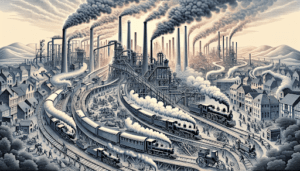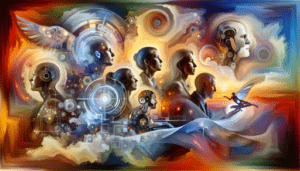Adapting to technological change is vital for staying competitive. This article will guide you through practical strategies to embrace new technologies effectively. From learning historical lessons of the Industrial Revolution to modern-day adjustments, we provide insights and actionable advice to help you thrive in an ever-evolving landscape.
Key Takeaways
- Drawing parallels between the Industrial Revolution and today’s technological upheaval can help understand how transformative innovations reshape industries and challenge existing economic and social paradigms.
- Modern-day adjustments in thinking, such as fostering a culture of continuous learning and agility, are imperative for organizations to effectively embrace and adapt to new technologies.
- Historical lessons from the Industrial Revolution emphasize the need for business leaders to rethink models, build trust, focus on customer-centric designs, and leverage technological advancements for sustained growth and innovation.
Learning from the Past: Technological Changes During the Industrial Revolution
The emergence of new technology during the Industrial Revolution illuminated a path of innovation beginning in mid-18th century Great Britain. With mechanization at its forefront, this blaze of tech advances was later mirrored by the American Industrial Revolution throughout the Gilded Age and persisted up until World War II. Central to this transformative period was the invention of the steam engine, which significantly decreased manufacturing timeframes while augmenting production capabilities.
This epoch witnessed an explosion of creative technological solutions: innovations like assembly lines revolutionized work processes, communication was transformed with inventions such as telegraph systems, and transportation evolved with developments including internal combustion engines. Coal powered these advancements, surpassing wood as a prime source for energy generation that propelled society forward into unprecedented growth. The implementation shifted dynamics both within workplaces and homes, leading to urban expansion due to factory proliferation—fundamentally altering economic practices from traditional agriculture toward industrial manufacturing.
These shifts had deep-seated implications that resonated through generations: they redrew societal constructs, breathed new life into global economies, and altered humanity’s developmental trajectory forevermore. As we navigate our current landscape shaped by rapid evolution in tech innovation—the legacy left behind by those times serves as both inspiration and warning about embracing new technologies while recognizing their capacity to reshape our world necessitating continual adaptation amidst change.
Drawing Parallels Between the Industrial Revolution and Today’s Technological Landscape
The Industrial Revolution and the current era of technological upheaval share a common narrative of disruption. Just as the steam engine redefined production, today’s innovations like artificial intelligence are reshaping industries, challenging our concepts of work, and raising questions about economic growth and inequality. The automation of both manual and cognitive tasks is a hallmark of our times, echoing the past’s impact on manual labor.
While the Industrial Revolution was a wave that primarily swept through industrialized nations, today’s technological tide is global, its reach extending from Silicon Valley to the farthest corners of the earth. No sector remains untouched; medicine, education, and finance are all being redefined by tech. As industries converge and digital platforms dominate, businesses must innovate or face obsolescence.
The Fourth Industrial Revolution blurs the lines between physical and digital, with smart factories and the Internet of Things shaping a new world where traditional industry boundaries are eroded. This evolution demands a strategic rethinking of roles, as routine tasks give way to management and problem-solving in the face of automation. As we draw parallels with the past, it’s crucial to understand these shifts to stay ahead in today’s fast-paced technological landscape.
Mindset Shifts During the Industrial Revolution
Throughout the Industrial Revolution, rapid economic expansion and technological progress were prioritized, often sidelining concerns for environmental preservation. This period introduced:
- An unquenchable thirst for raw materials
- A pattern of production from inception to disposal
- The pursuit of swifter and more cost-effective manufacturing processes with significant repercussions on both ecology and society
- A fascination with product aesthetics that promoted planned obsolescence
- An emergence of a perpetual consumption ethos
During this era, consumer habits shifted toward:
, Preferring quantity over quality as goods were produced in greater volumes than ever before.
- Transitioning from an emphasis on how products were made to focusing on branding strategies. Thus corporate image and promotional efforts started overshadowing craftsmanship.
Deploying offshore manufacturing as a way to reduce expenses highlighted the importance of company brand recognition.
The widespread use of plastic items along with single-use commodities profoundly modified purchasing behaviors, laying groundwork for today’s throwaway culture. As we consider these shifts in historical perspectives, it becomes clear that choices made during the Industrial Revolution have cast long-lasting shadows across current industrial practices and consumer tendencies. While adapting was crucial then just as it is now, reflecting upon past experiences reminds us about integrating sustainability alongside innovation within our business values.
Modern-Day Adjustments in Thinking to Embrace New Technologies
To flourish in the face of technological change, a shift in mindset is crucial. Being agile, engaging with communities for collaboration, and being receptive to change are critical elements needed to effectively incorporate new tech. Creating an organizational culture that prioritizes learning ensures employees keep pace with the latest tech advancements through ongoing education initiatives.
For organizations aiming to swiftly and efficiently adapt to new technologies, various techniques become part of their arsenal including:
- Experiential hands-on training
- Bite-sized microlearning modules
- Collaborative peer-to-peer instruction sessions
- Practical project-based applications
- Easily accessible on-demand courses
These approaches not only enable practical skills enhancement but also allow learners autonomy over their pace and methodology. Virtual reality (VR) and augmented reality (AR), as tools within this spectrum, provide rich simulated environments that can improve proficiency while maintaining safety standards.
Navigating towards successful adaptation requires creative thought processes along with openness—whether it be in academic or professional arenas. It’s pivotal for any organization seeking effective operation of digital tools and systems to invest in bolstering its workforce’s technical savvy. As we traverse through our evolving world, devising strategies aimed at fostering innovation — along with endorsing agility — and perpetuating lifelong learning becomes integral for remaining competitive.
Essential Books on the Industrial Revolution
For those eager to delve into the historical depths of the Industrial Revolution and its profound impact on the world, we’ve made a curated list of books about the Industrial Revolution. Each selection is accompanied by a brief description, underscoring its unique contributions and reasons why it’s an indispensable resource for students and enthusiasts of industrial history.
- ‘The Unbound Prometheus’ by David Landes – This classic offers a sweeping narrative that captures the essence of the Industrial Revolution’s economic and social impact. Landes’s detailed analysis makes it a must-read for understanding the technological innovations that shaped modern industry.
- ‘Growth Recurring’ by Eric Jones – Jones’s work takes a global perspective on economic development, providing a broader context for the Industrial Revolution. It’s essential for those looking to comprehend the patterns of economic growth across different societies.
- ‘The British Industrial Revolution in Global Perspective’ by Robert C. Allen – Allen provides a quantitative analysis of the Industrial Revolution, arguing that high wages and cheap energy costs were pivotal to Britain’s industrial success. His focus on economic factors makes this book crucial for understanding the financial underpinnings of the era.
- ‘The Enlightened Economy’ by Joel Mokyr – Mokyr explores the cultural and intellectual foundations of the Industrial Revolution, which he terms the ‘Industrial Enlightenment’. This book is key for readers interested in the origins of innovation and the role of ideas in economic transformation.
- ‘The Industrial Revolution in Britain’ by Nick Crafts – Crafts integrates the latest research to reassess the Industrial Revolution, emphasizing the importance of incremental technological improvements. It’s an insightful read for those who want to grasp the subtleties of technological progress and its effects on society.
The knowledge gained from these seminal works provides a solid foundation for understanding the Industrial Revolution’s complex tapestry. As we transition from exploring these essential texts, we move towards examining historical examples that illustrate how new technologies were successfully integrated during this transformative period.
Historical Examples of Integrating New Technologies
The Industrial Revolution provided numerous historical examples of successful integration of new technology. Jethro Tullahan. Tull’s seed drill revolutionized agriculture, boosting productivity and setting a new precedent for efficiency. The coal-fired steam engine, perfected by James Watt, became a cornerstone of British industry, allowing factories to be located independently of water sources.
Inventions like the spinning jenny and power loom transformed cotton production from a cottage industry to a mechanized powerhouse. The development of wrought iron production techniques, like the puddling process, allowed for advancements in machinery and heavy industry. Furthermore, the rise of railways, powered by high-pressure steam engines, not only revolutionized transportation, but also expanded the industrial society of the 19th century.
These historical examples underscore the transformative power of integrating new technologies into the marketplace. They serve as blueprints for innovation and implementation in today’s ever-evolving tech landscape.
Lessons from the Industrial Revolution for Today’s Business Leaders
The Industrial Revolution holds valuable lessons for today’s business leaders. One of the most pertinent is the necessity of rethinking business models to adapt to new technological ecosystems. Balancing the integration of new tech with patience to ensure seamless adoption is crucial. Moreover, focusing on a clear purpose rather than just products can build stronger customer trust and differentiate businesses.
In an era where data is king, trustworthiness in its management is a significant differentiation for companies. Prioritizing human values and fostering connections among people is essential for effective leverage of technological advancements. Today’s leaders must build trust and clarity of purpose to navigate the turbulence of continuous change.
Customer-centric designs and innovative financing models, like subscription-based services, can create lasting relationships and fund continuous technological advancements. These historical insights are invaluable for modern businesses looking to innovate and grow in an increasingly tech-driven world.
Case Studies Illustrating Successful Adaptation
The Industrial Revolution offers a treasure trove of case studies illustrating successful adaptation to technological change. The adoption of mechanized spinning and weaving in textile factories is a prime example, where productivity surged, and labor costs plummeted. The introduction of steam engines in manufacturing allowed for a significant leap in production efficiency.
The expansion of railways enabled the fast transportation of goods and raw materials, contributing to the growth of industries and broadening market reach. The Bessemer process for steel production made steel more affordable and accessible, greatly impacting construction and engineering projects.
These historical case studies provide valuable examples for contemporary businesses, showing how embracing change and adapting strategies can lead to success in a world of new technologies.
Actionable Advice for Business Leaders Based on Historical Insights
Reflecting on historical examples, a number of key recommendations stand out for business leaders navigating today’s technology-centric marketplace. Leaders must not only keep abreast of but also wholeheartedly embrace emerging technologies to stay relevant and competitive. By adapting swiftly to new tech, they can steer their organizations towards innovation and maintain an edge in the market.
An organization that neglects to update its technological capabilities risks obsolescence and financial decline as competitors forge ahead. To minimize resistance within teams when integrating new tools, it is important to offer regular feedback while clearly outlining the advantages these advancements bring in alignment with team objectives.
Investment in professional training programs that enhance understanding of cutting-edge technologies will accelerate the learning process across the company. As roles evolve alongside technological advancements, it becomes imperative for all staff members at every level to develop competencies with modern systems and refine their repertoire with newly required skills.
Importance of Learning from the Industrial Revolution
Understanding the Industrial Revolution’s legacy is vital. It sheds light on:
- The parallel development of job demands and educational standards
- Society’s transformation due to technological innovation
- Both the difficulties and prospects that come with tech progress
Crucially, exploring the Industrial Revolution equips us with essential knowledge for coping with today’s technology shifts.
By drawing lessons from earlier times, we can more effectively gear up for today’s and tomorrow’s tech evolution, making sure we stay relevant in an ever-evolving world. Examining both triumphs and hurdles during the Industrial Revolution enables us to craft strategies designed to succeed amid ongoing technological transformations defining our era and beyond.
Summary
In summary, the lasting impact of the Industrial Revolution resonates within our current technological environment, providing enduring insights into adaptation, innovation, and human resilience. Learning from how those before us steered through transformative periods enables us to confidently and proactively traverse today’s digital era. Grasping historical lessons offers a navigational tool for managing the intricacies and seizing the chances that come with technological change.
Frequently Asked Questions
How did the Industrial Revolution impact the environment?
The environmental impact of the Industrial Revolution was considerable, resulting in heightened extraction of natural resources, escalated levels of pollution, and the emergence of throwaway products.
These outcomes have persisted over time, causing enduring environmental effects.
Are there modern equivalents to the steam engine in terms of impact on industry?
Indeed, contemporary technologies including artificial intelligence, digital platforms, and the Internet of Things have an impact on par with that of the steam engine by transforming industries and altering the dynamics of the global market.
What mindset shifts are necessary for today’s workforce to adapt to new technologies?
Today’s workforce must cultivate agility, ongoing learning, and a mindset open to new ideas in order to adapt successfully to the constantly changing landscape of tech and maintain their competitive edge.
It is crucial for harnessing the full potential of emergent technologies that individuals adopt these traits.
Why is understanding the history of technology important for modern business leaders?
Business leaders today can gain invaluable insights for strategic decision-making and adaptability in a swiftly evolving technological environment by studying the history of technology. Learning from how adaptations were managed in the past enables them to innovate effectively and craft strategies that incorporate new technologies, ensuring their relevance in the current global landscape. This understanding equips them with the knowledge necessary for successful integration of modern technologies into their business practices.
How can businesses today ensure they are effectively adapting to technological changes?
Businesses must cultivate an environment that emphasizes continuous learning and actively encourages teams to adopt new technologies in order to stay abreast of technological advancements. By gathering feedback, they can fine-tune their strategies for integrating these technologies.
Ensuring successful adaptation to tech changes hinges on this proactive approach toward embracing evolving tech trends and refining how businesses assimilate them into their operations.









